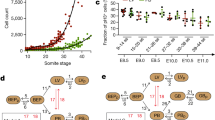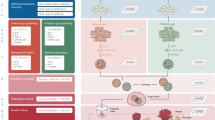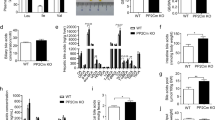Abstract
The biliary system, pancreas and liver all develop from the nearby foregut at almost the same time in mammals. The molecular mechanisms that determine the identity of each organ in this complex area are unknown. Hes1 encodes the basic helix-loop-helix protein Hes1 (ref. 1), which represses positive basic helix-loop-helix genes2 such as Neurog3 (ref. 3). Expression of Hes1 is controlled by the evolutionarily conserved Notch pathway4. Hes1 operates as a general negative regulator of endodermal endocrine differentiation5,6, and defects in Notch signaling lead to accelerated pancreatic endocrine differentiation7,8. Mutations in JAG1, encoding a Notch ligand, cause the Alagille syndrome in humans9,10, characterized by poor development of the biliary system11, suggesting that the Notch pathway is also involved in normal biliary development. Here we show that Hes1 is expressed in the extrahepatic biliary epithelium throughout development and that Hes1-deficient mice2 have gallbladder agenesis and severe hypoplasia of extrahepatic bile ducts. Biliary epithelium in Hes1−/− mice ectopically expresses the proendocrine gene Neurog3 (refs. 12,13), differentiates into endocrine and exocrine cells and forms acini and islet-like structures in the mutant bile ducts. Thus, biliary epithelium has the potential for pancreatic differentiation and Hes1 determines biliary organogenesis by preventing the pancreatic differentiation program, probably by directly repressing transcription of Neurog3.
This is a preview of subscription content, access via your institution
Access options
Subscribe to this journal
Receive 12 print issues and online access
$259.00 per year
only $21.58 per issue
Buy this article
- Purchase on SpringerLink
- Instant access to full article PDF
Prices may be subject to local taxes which are calculated during checkout






Similar content being viewed by others
References
Sasai, Y., Kageyama, R., Tagawa, Y., Shigemoto, R. & Nakanishi, S. Two mammalian helix-loop-helix factors structurally related to Drosophila hairy and Enhancer of split. Genes Dev. 6, 2620–2634 (1992).
Ishibashi, M. et al. Targeted disruption of mammalian hairy and Enhancer of split homolog-1 (HES-1) leads to up-regulation of neural helix-loop-helix factors, premature neurogenesis, and severe neural tube defects. Genes Dev. 9, 3136–3148 (1995).
Sommer, L., Ma, Q. & Anderson, D.J. Neurogenins, a novel family of atonal-related bHLH transcription factors, are putative mammalian neuronal determination genes that reveal progenitor cell heterogeneity in the developing CNS and PNS. Mol. Cell Neurosci. 8, 221–241 (1996).
Jarriault, S. et al. Signalling downstream of activated mammalian Notch. Nature 377, 355–358 (1995).
Jensen, J. et al. Control of endodermal endocrine development by Hes-1. Nat. Genet. 24, 36–44 (2000).
Skipper, M. & Lewis, J. Getting to the guts of enteroendocrine differentiation. Nat. Genet. 24, 3–4 (2000).
Apelqvist, A. et al. Notch signalling controls pancreatic cell differentiation. Nature 400, 877–881 (1999).
Edlund, H. Pancreatic organogenesis—developmental mechanisms and implications for therapy. Nat. Rev. Genet. 3, 524–532 (2002).
Li, L. et al. Alagille syndrome is caused by mutations in human Jagged1, which encodes a ligand for Notch1. Nat. Genet. 16, 243–251 (1997).
Oda, T. et al. Mutations in the human Jagged1 gene are responsible for Alagille syndrome. Nat. Genet. 16, 235–242 (1997).
Alagille, D., Odievre, M., Gautier, M. & Dommergues, J.P. Hepatic ductular hypoplasia associated with characteristic facies, vertebral malformations, retarded physical, mental, and sexual development, and cardiac murmur. J. Pediatr. 86, 63–71 (1975).
Gradwohl, G., Dierich, A., LeMeur, M. & Guillemot, F. Neurogenin3 is required for the development of the four endocrine cell lineages of the pancreas. Proc. Natl. Acad. Sci. USA 97, 1607–1611 (2000).
Schwitzgebel, V.M. et al. Expression of neurogenin3 reveals an islet cell precursor population in the pancreas. Development 127, 3533–3542 (2000).
Ohtsuka, T. et al. Hes1 and Hes5 as notch effectors in mammalian neuronal differentiation. EMBO J. 18, 2196–2207 (1999).
Shiojiri, N. & Katayama, H. Development of Dolichos biflorus agglutinin (DBA) binding sites in the bile duct of the embryonic mouse liver. Anat. Embryol. (Berl.) 178, 15–20 (1988).
Pang, K., Mukonoweshuro, C. & Wong, G.G. Beta cells arise from glucose transporter type 2 (Glut2)-expressing epithelial cells of the developing rat pancreas. Proc. Natl. Acad. Sci. USA 91, 9559–9563 (1994).
Herrera, P.L. Adult insulin- and glucagon-producing cells differentiate from two independent cell lineages. Development 127, 2317–2322 (2000).
Ahlgren, U., Pfaff, S.L., Jessell, T.M., Edlund, T. & Edlund, H. Independent requirement for ISL1 in formation of pancreatic mesenchyme and islet cells. Nature 385, 257–260 (1997).
Elliott, W.M. & Youson, J.H. Development of the adult endocrine pancreas during metamorphosis in the sea lamprey, Petromyzon marinus L. II. Electron microscopy and immunocytochemistry. Anat. Rec. 237, 271–290 (1993).
Kawaguchi, Y. et al. The role of the transcriptional regulator Ptf1a in converting intestinal to pancreatic progenitors. Nat. Genet. 32, 128–134 (2002).
Golosow, N. & Grobstein, C. Epitheliomesenchymal interaction in pancreatic morphogenesis. Dev. Biol. 4, 242–255 (1962).
Kim, S.K. & Hebrok, M. Intercellular signals regulating pancreas development and function. Genes Dev. 15, 111–127 (2001).
Zaret, K.S. Hepatocyte differentiation: from the endoderm and beyond. Curr. Opin. Genet. Dev. 11, 568–574 (2001).
Ohlsson, H., Karlsson, K. & Edlund, T. IPF1, a homeodomain-containing transactivator of the insulin gene. EMBO J. 12, 4251–4259 (1993).
Ahlgren, U., Jonsson, J. & Edlund, H. The morphogenesis of the pancreatic mesenchyme is uncoupled from that of the pancreatic epithelium in IPF1/PDX1-deficient mice. Development 122, 1409–1416 (1996).
Lee, J.C. et al. Regulation of the pancreatic pro-endocrine gene Neurogenin3. Diabetes 50, 928–936 (2001).
Kaneta, M. et al. A role for Pref-1 and HES-1 in thymocyte development. J. Immunol. 164, 256–264 (2000).
Tomita, K., Moriyoshi, K., Nakanishi, S., Guillemot, F. & Kageyama, R. Mammalian achaete-scute and atonal homologs regulate neuronal versus glial fate determination in the central nervous system. EMBO J. 19, 5460–5472 (2000).
Acknowledgements
We thank M. Nagata, M. Kobayashi, S. Takahashi, Y. Kawachi, T. Yamaoka and M. Itakura for critical discussions and T. Ohto, S. Itoh, N. Kajiwara and R. Hirochika for technical assistance.
Author information
Authors and Affiliations
Corresponding author
Ethics declarations
Competing interests
The authors declare no competing financial interests.
Rights and permissions
About this article
Cite this article
Sumazaki, R., Shiojiri, N., Isoyama, S. et al. Conversion of biliary system to pancreatic tissue in Hes1-deficient mice. Nat Genet 36, 83–87 (2004). https://doi.org/10.1038/ng1273
Received:
Accepted:
Published:
Issue date:
DOI: https://doi.org/10.1038/ng1273
This article is cited by
-
Biliary atresia: the development, pathological features, and classification of the bile duct
Pediatric Surgery International (2024)
-
Comparative study on a novel lobule structure of the zebrafish liver and that of the mammalian liver
Cell and Tissue Research (2022)
-
Engineering human hepato-biliary-pancreatic organoids from pluripotent stem cells
Nature Protocols (2021)
-
Porcine models for studying complications and organ crosstalk in diabetes mellitus
Cell and Tissue Research (2020)
-
A morphogenetic EphB/EphrinB code controls hepatopancreatic duct formation
Nature Communications (2019)



